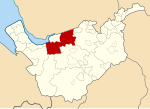Runcorn signal box
1940 establishments in EnglandBuildings and structures in RuncornEngvarB from December 2013Grade II listed buildings in CheshireSignal boxes in the United Kingdom ... and 2 more
Transport infrastructure completed in 1940Use British English from December 2023

Runcorn signal box is a railway control building sited at the south end of Runcorn railway station in Cheshire, England. It is located to the west of the West Coast Main Line and the branch line to Folly Lane. The signal box is recorded in the National Heritage List for England as a designated Grade II listed building. It was built by the London, Midland and Scottish Railway (LMS) in the early years of the Second World War incorporating the specifications of the Air Raid Precautions (ARP), and was one of the first of such signal boxes to be operational.
Excerpt from the Wikipedia article Runcorn signal box (License: CC BY-SA 3.0, Authors, Images).Runcorn signal box
Holloway,
Geographical coordinates (GPS) Address Nearby Places Show on map
Geographical coordinates (GPS)
| Latitude | Longitude |
|---|---|
| N 53.33731 ° | E -2.73874 ° |
Address
Holloway
WA7 4TG , Higher Runcorn
England, United Kingdom
Open on Google Maps










